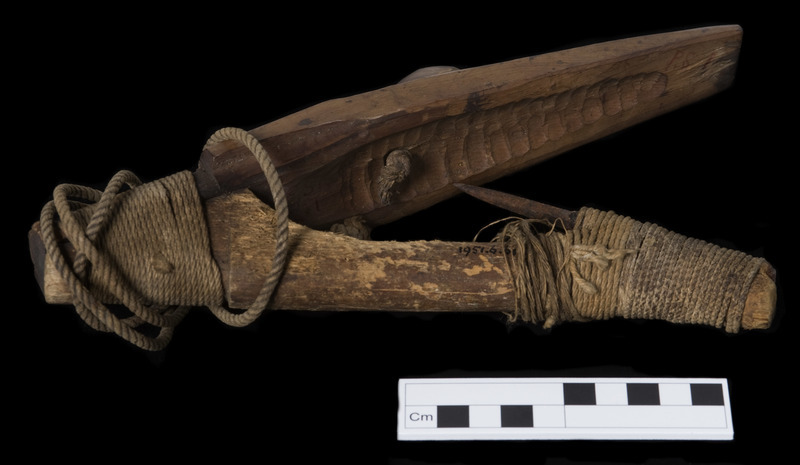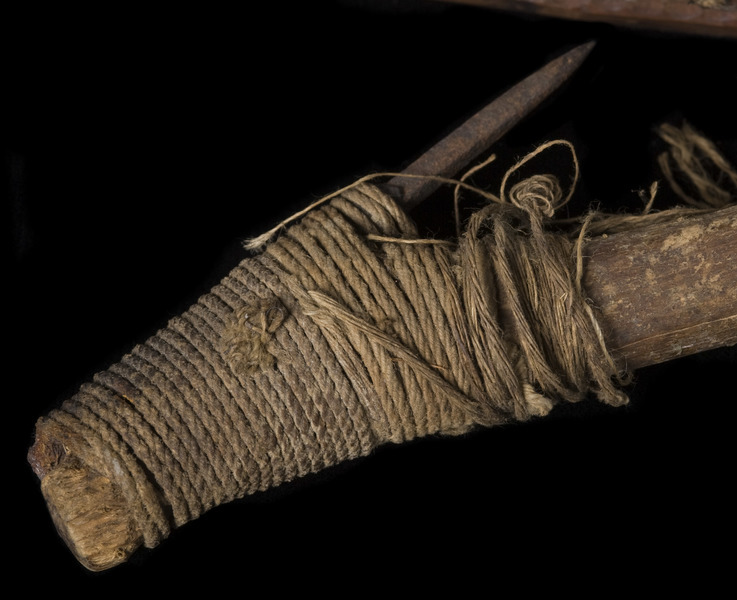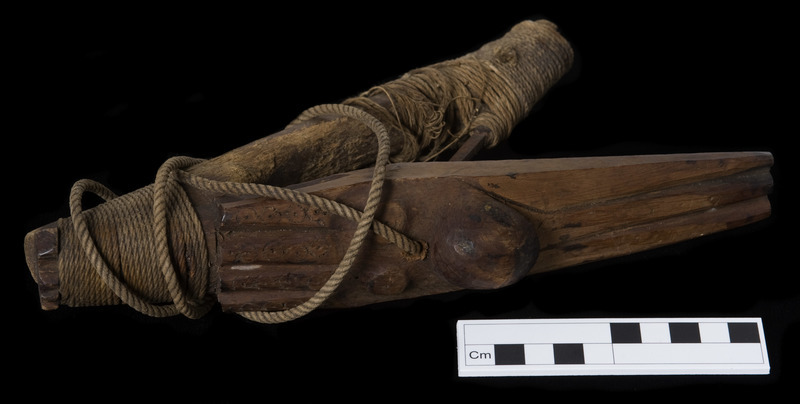Hook Item Number: 1951.6.61 from the Pitt Rivers Museum




Description
Wooden halibut hook with iron nail bound on as barb and carved with an octopus figure. [CAK 26/06/2009]
Longer Description
Wooden halibut hook with iron nail bound on as barb and carved with an octopus figure. The hook is carved from two pieces of wood, nailed and lashed together with string to form an acute angle. On one arm of the hook, an iron barb has been positioned such that it faces toward the second arm, and lashed in place with two kinds of string. A third kind of string is loosely wrapped above the lashing but does not seem to hold anything in particular in place. The other arm is carved with an octopus: there are four short appendages near the lashing, with circular decorations resembling suction cups; two round eyes, a bulbous form, and then three long appendages, some faintly decorated with circles or suction cup motif. This arm of the hook has been perforated between the figures eyes and a length of cord inserted and knotted on either end. The reverse of this arm has been roughly carved out to leave a concave impression. [CAK 26/06/2009]
Primary Documentation
Accession Book Entry - 'WELLCOME HISTORICAL MEDICAL MUSEUM, 28 PORTMAN SQUARE, LONDON, W.1...1951.6.61 HAIDA INDIANS. Wooden halibut hook with iron nail bound on as barb. Upper part of shank carved with conventional human face with head-dress. Max. length 26.3 cm.
There is no further information on the catalogue card. [CW 11 6 98]
Pitt Rivers Museum label - BRITISH COLUMBIA HAIDA INDIANS Halibut Hook Gift of the Wellcome Historical Medical Museum [MJD 02/04/2009]
Written on object - P.S. No No 1 [MJD 02/04/2009]
Written on object - PS 1 [MJD 02/04/2009]
Related Documents File - Letter from E. Ashworth Underwood [Director, The Wellcome Historical Medical Museum] to T. K. Penniman dated 30 January, 1951, inviting the Pitt Rivers Museum to send a representative to select items from the Wellcome collection, housed temporarily at the British Museum. [GI 4/2/2002]
Related Documents File - The Haida Project Related Documents File contains video of research sessions and interviews with Haida delegates from September 2009 as part of the project ‘Haida Material Culture in British Museums: Generating New Forms of Knowledge'. It also includes post-visit communications that discuss object provenance. For extensive photographic, video, and textual records documenting the Haida research visit as a whole, including but not limited to preparations of objects for handling, travel logistics, British Museum participation, transcribed notes from research sessions and associated public events held at PRM, see the Haida Project Digital Archive, stored with the Accessions Registers. Original hand-written notes taken during research sessions have been accessioned into the Manuscripts collection, in addition to select other materials. [CAK 02/06/2010]
Research Notes
The following information comes from Haida delegates who worked with the museum's collection in September 2009 as part of the project “Haida Material Culture in British Museums: Generating New Forms of Knowledge”:
This hook was viewed alongside other fish hooks on Monday Sept 14, 2009. Delegates consistently identified the figure as an octopus. Delegates commented on sucker pattern on this hook - the small circle with central dot - and the presence of this design on various objects throughout the collection and especially the spoons. Octopus were reported as bait used for halibut fishing as the fish would chew on it for long enough to allow the fishermen to catch them. The bottom of the hook with the barb was identified as cedar, a softer wood that would float above the other segment of the hook carved with the octopus from yew wood, a heavier/harder wood. The hook therefore sits 'upside down' in the water. (Christian White noted that because of the iron barb used for the hook, the arm would want to sink, and therefore it is likely that a float would be required to keep the hook in the proper position.) When hooked, it was explained that the halibut would flip and the water would run the wrong way along the gills, disorientating and suffocating the fish, making it easier to reel in.
Delegates suggested the line might have been made from spruce root and stinging nettle.
Some delegates distinguished halibut hooks as being angled or triangular in shape, in comparison to cod hooks which they described as rounded or curved. However, there was discrepancy among delegates that this was an accurate way to divide and identify hooks.
The hooks and wood are bound together using particular tying techniques. This involves laying a length of thread loose along the length of the wood that is to be bound to the hook and binding that under the wound cord. Once enough cord has been wound about the wood and hook this thread is picked back up and used to tie the other end off and to clamp together the sinew / fibres used to tie the hook up. This helps to guard against the binding coming loose as the hook is submerged and begins to absorb water, or as the fish takes hold.
To gauge the hook size a maker would use the width of their thumb across the joint inserted between the bone hook and the outer wooden frame.[CAK 20/05/2010]
Item History
- Made in British Columbia Haida Gwaii NW Coast, Canada
- Received from Wellcome Historical Medical Museum during 1951
What
- Name
- Hook
- Identification Number
- 1951.6.61
- Type of Item
- hook
- Material
- wood, iron metal, string, spruce root plant ? and nettle fibre plant ?
- Manufacturing Technique
- carved, bound, nailed, twisted, perforated and knotted
- Overall
- length 263.0 mm
Who
- Culture
- Haida
- Received from
- Wellcome Historical Medical Museum
Where
- Holding Institution
- Pitt Rivers Museum
- Made in
- British Columbia Haida Gwaii NW Coast, Canada
When
- Acquisition Date
- during 1951
Other
- Keyword
- Hook; Figure; Fishing Accessory
- Class
- Figure; Fishing